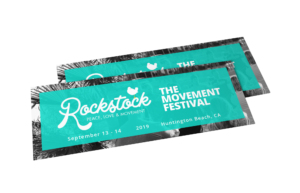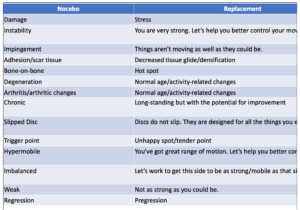by Mitch Hauschildt, MA, ATC, CSCS
This past weekend saw Rockstock 2019 come and go and I have to say that it was the best Rocktape movement summit yet. This is not only my opinion, but the opinion of the vast majority of people that I spoke with.
Rocktape always does a great job with the event by combining great education with an awesome location and of course tons of fun. This year was no different. The event was held at a beachside hotel in Huntington Beach, California so the views were nothing short of amazing. The Friday night party was a classic Rocktape event with music, dancing, food and drinks. I love Rockstock for a number of reasons, but I have to say that the people are always my biggest reason for returning. Everyone is always in a great mood at Rockstock and the networking opportunities abound every day.
I want to dedicate the rest of this week’s blog post to sharing some of my big takeaways from the 2 day movement event. Here they are in no particular order:
- This year’s Rockstock had a very large neurological theme with regards to movement and discussed a lot about movement experiences, pain science, and movement variation. These principles can and should be applied to virtually all populations and environments.
- “We can’t change the experience, but we can change how we feel about it.” This is something that I think we can all do a better job of understanding (especially me). What they are saying is that pain and injury are going to cause a unique experience that for some people is very traumatic and we can’t change that experience. Our job as we help them heal is to help them to understand the experience, what it means for them going forward, and how to appropriately deal with it. We have to remember that pain is a construct of the neuromatrix and is very complex in nature. Helping our patients understand that how they think about their pain and injury is just as, if not more important as any tissue damage that occurred.
- Along those same lines, the words that we choose are very important. Dr Shante Cofield (i.e. the Movement Maestro) presented a word chart that is helpful fo
 r us to use when speaking with our patients. I understand that this is a bit “touchy feely” for some of our patients, but I will also tell you that on Monday I had an athlete discussing her pain with me and the way it was described by her PT at home over the summer made it very scary to her. So, depending on the patient and injury, these suggestions are very valid.
r us to use when speaking with our patients. I understand that this is a bit “touchy feely” for some of our patients, but I will also tell you that on Monday I had an athlete discussing her pain with me and the way it was described by her PT at home over the summer made it very scary to her. So, depending on the patient and injury, these suggestions are very valid. - We may want to consider using Craig’s test to evaluate femoral torsion and how it affects the squat movement with some of our athletes. Craig’s test is easy to find online (I was not familiar with it) and can help us to understand if anatomically someone can even get into the positions that we are asking them to at times.
- “You can’t shoot a canon from a canoe”. We have to teach our patients and clients to better stabilize before they can even attempt complex movements.
- Research is showing that less coaching and cuing is better for most people than feed forward/over coaching. They are now suggesting that most people will develop an efficient movement strategy if we put them into positions to succeed and allow them to explore the pattern. Cuing things like “squeeze that”, “contract here”, or “activate ___” don’t appear to have much carry over to our actual movement patterns, thus they aren’t all that helpful. It is appearing more and more that using external cues (i.e. “touch your hips to the wall behind you” or “push the floor away”) are highly effective, as is using self limiting movements and implements. This includes exercises that if they aren’t done correctly, they aren’t accomplished at all and doing things like inverting a KB upside down so it changes the perceived risk or reward (I.e. I will be more focused on a get up with at KB bottoms up because the KB might hit me in the teeth if I’m not paying attention) are very effective at motor learning.
- We should consider using simple exercises such as Saccades and divergence within our MSK therapy to help resent the nervous system and clear out any crap. This should aid in motor learning and fine motor tasks.
- Vibration is on the same neurological track as 2 point discrimination and joint position sense. This is part of the reason that it works so well for so many of our athletes and clients. We need to continue to explore new uses for vibration including the powerplates, vibrating rollers, percussion massagers and manual vibration to reset the nervous system to aid in these important areas of movement.
- I spent some time with Dr Tim Brown, who is the predecessor and brains behind a lot of the skin drag techniques that we use with our tape at times. He is the inventor of Intelliskin, a line of performance clothes that is intended to help with posture, performance and joint position. They have been around for a few years and I haven’t been that impressed with it in the past. But, he showed me their latest iteration and I am intrigued to say the least. They have lined some strategic areas of their clothing with silicone that grips the skin really well. The idea is that you can position the grippers in the clothing in a way that will bias the skin to feed the brain and improve movement. So, in theory, you can position the shorts in a way that will feed the brain to externally rotated the femur to keep them out of valgus (or change pelvic position and so on). The same is true of their shirts. I have a pair of the shorts that I am going to personally play with and hopefully will get some more of their gear to explore. I think that there may be some nice applications for some of our athletes as an adjunct to taping and other modalities. I’ll keep you posted.
Overall, Rockstock is one of my favorite events of the year. If you didn’t make it, I’m sorry to hear it because they are taking next year off to regroup and make it even better for 2021. So, you’ll have to be patient until the next Rockstock comes around.


Leave a Reply